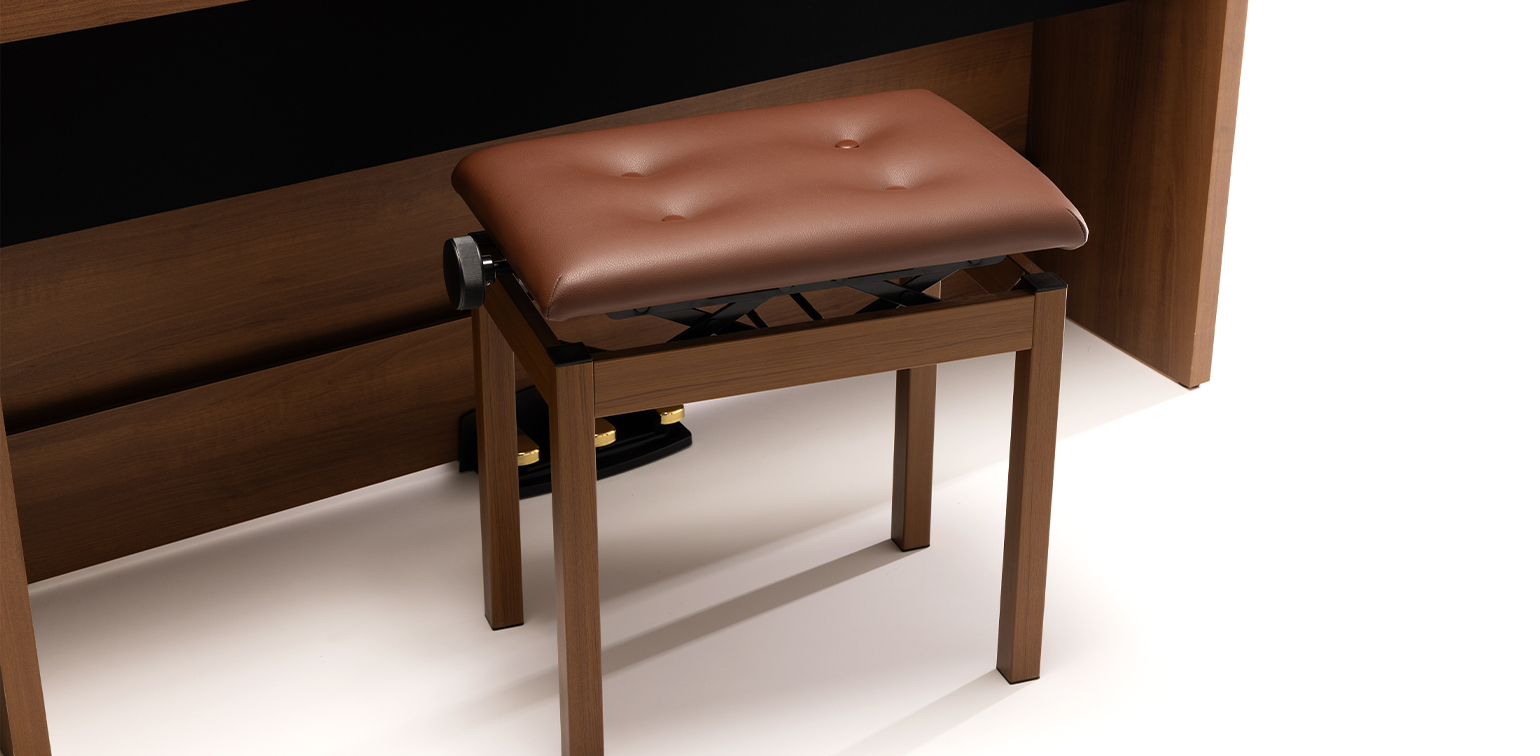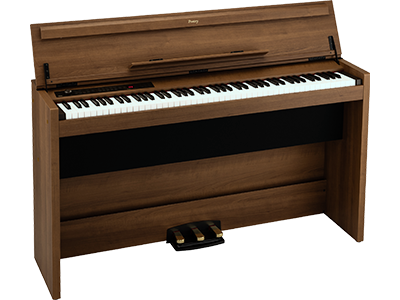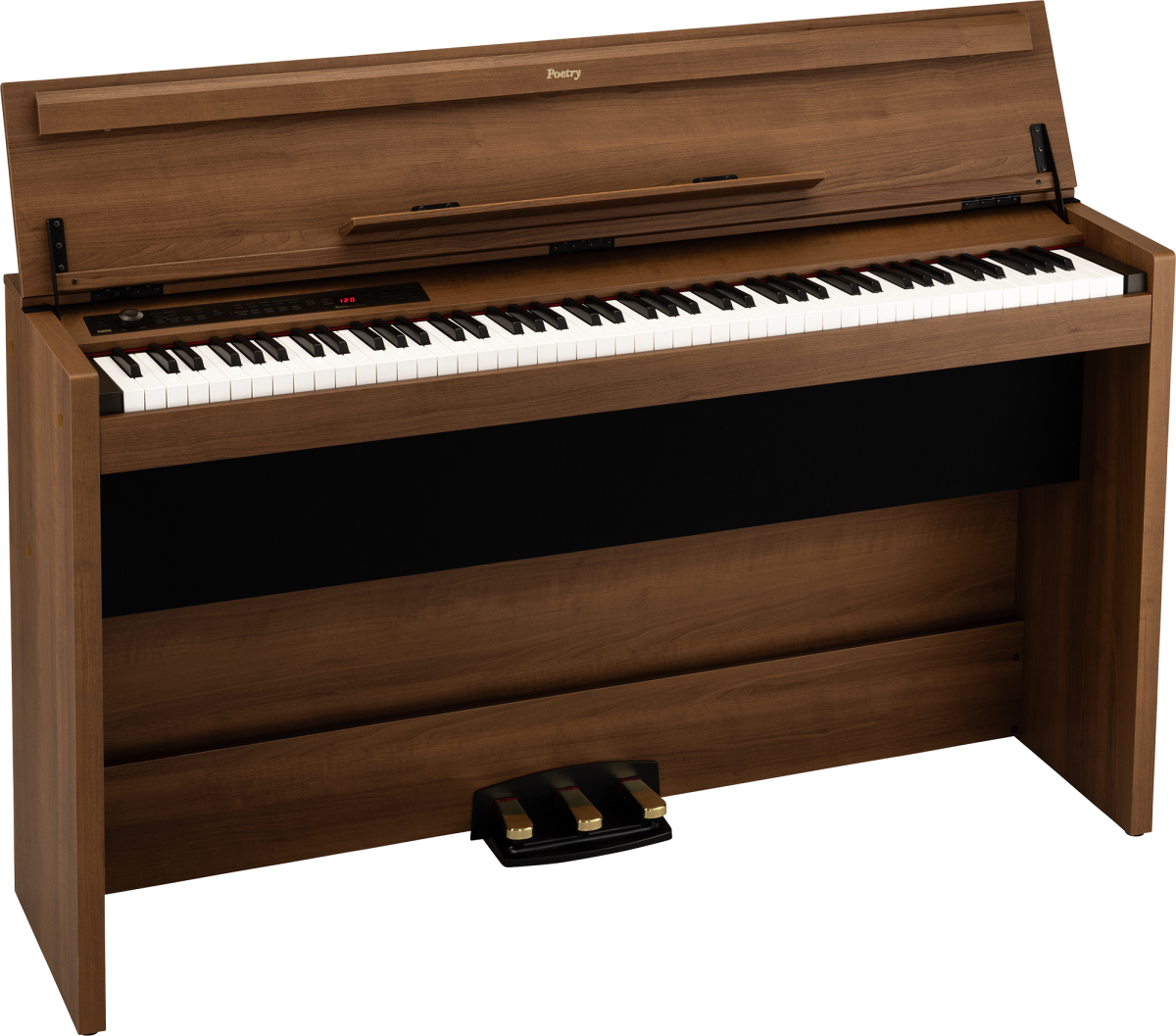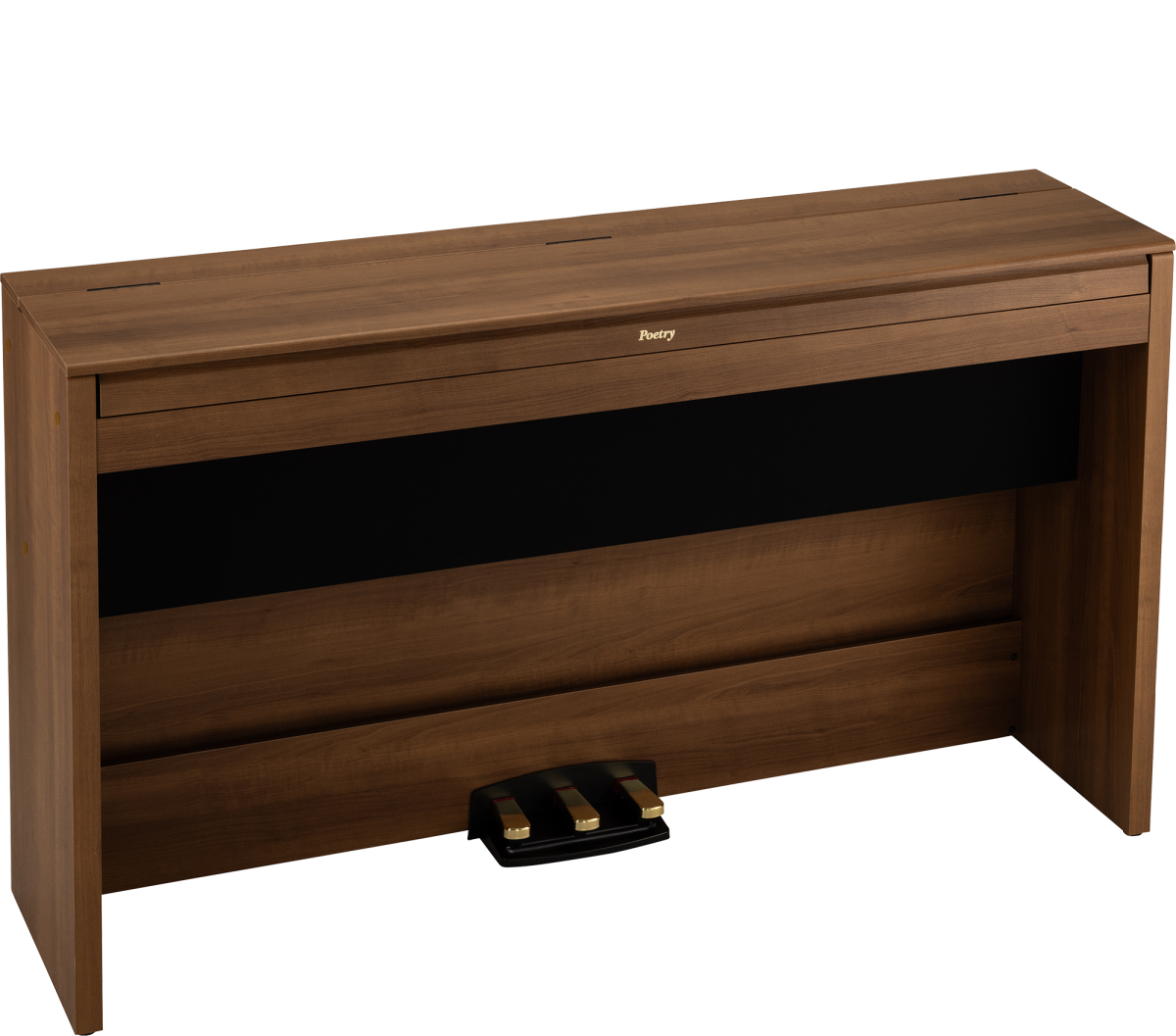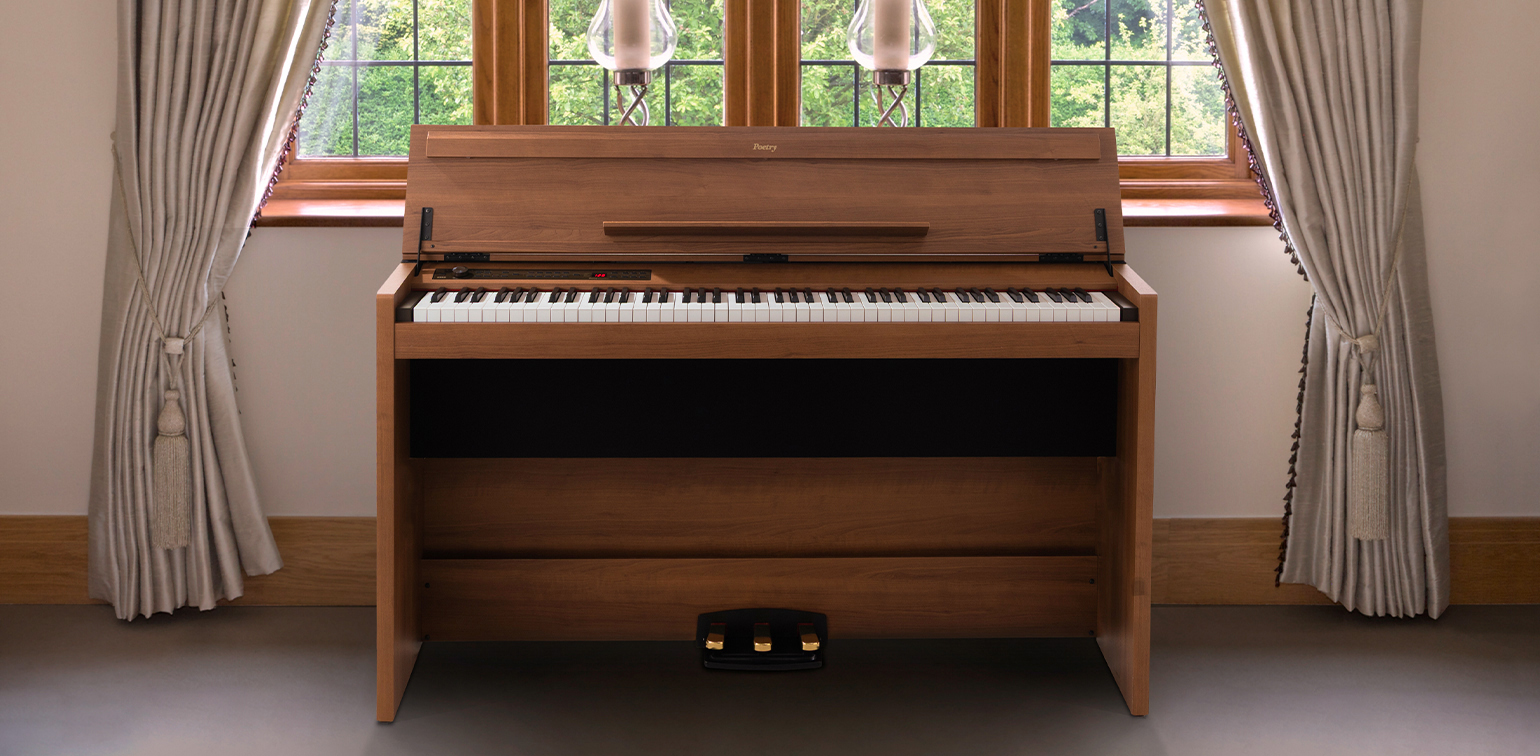
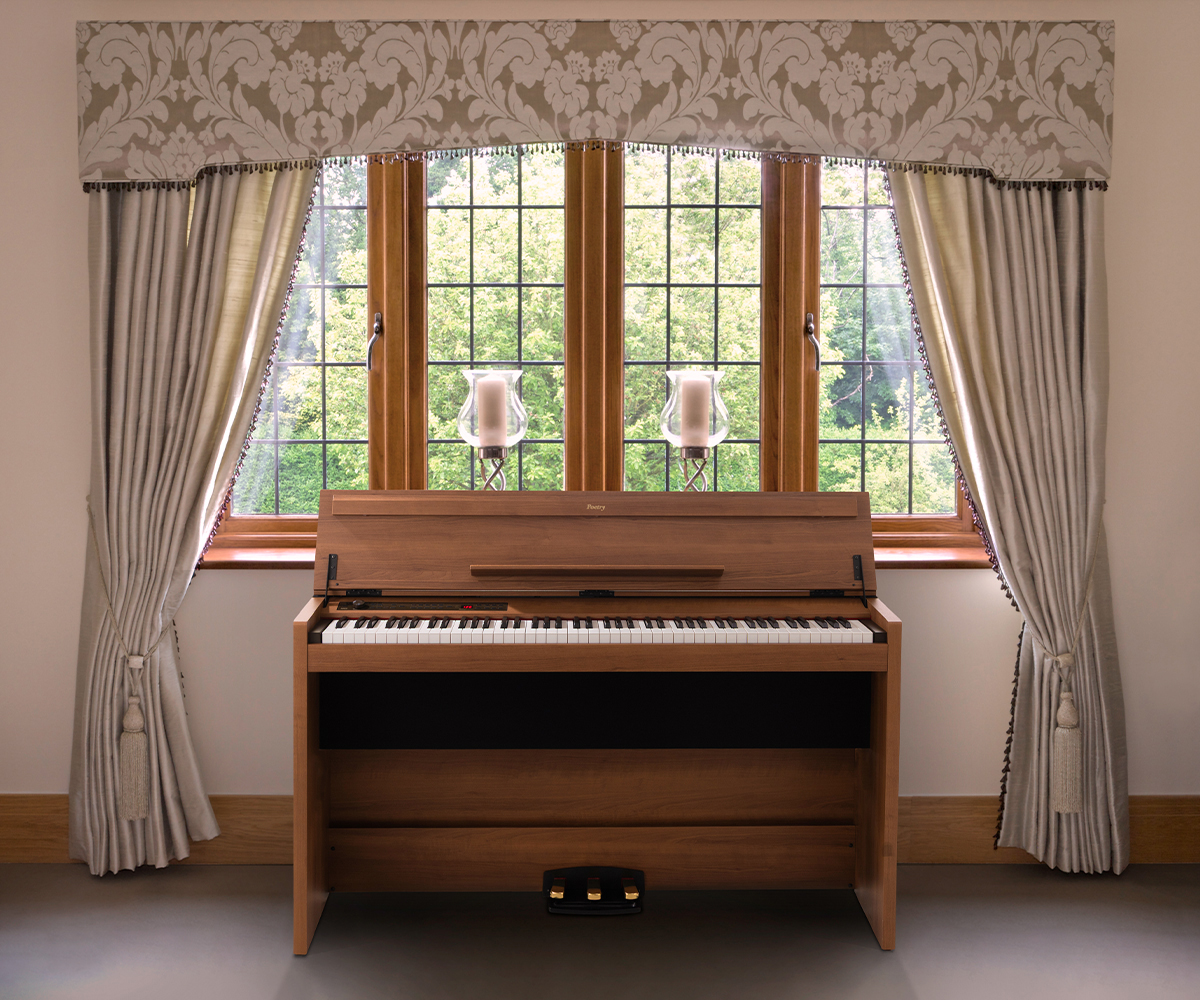
A Tribute to Chopin’s Beloved Sound
Experience the ultimate tribute to artistry and tradition. Chosen by today’s most acclaimed pianists in prestigious international competitions, the legendary Italian Concert Grand Piano now stands alongside the meticulously restored and faithfully sampled 1843 PLEYEL — Chopin’s own beloved instrument — in Poetry, the celebrated digital piano series. And now, a stunning new model makes its debut.
This latest evolution carries forward the two iconic piano sounds and elegant wood-grain finish, while unveiling a new design. Solid wood side panels enhance not only luxury but also strength and resonance, enclosing a newly engineered power unit that brings even greater depth and richness to every note played.
Named after the French word “Magnifique” — meaning “wonderful” and “splendid” — this instrument embodies our pursuit of the highest ideals in piano craftsmanship. With pride and passion, we dedicate this masterpiece to Chopin.
Two beautiful piano voices, united in one
Poetry Magnifique brings to life two extraordinary piano sounds: the majestic Italian Concert Grand Piano, cherished by world-class performers, and the timeless 1843 PLEYEL piano, lovingly restored and faithfully sampled.
Italian Concert Grand Piano
Europe is home to many prestigious piano brands, yet the Italian Concert Grand stands apart as the modern pianist’s choice. Selected and celebrated by countless performers at international competitions, it answers today’s demands for a new sound and a new expression. Its tone is brilliant, transparent, and full of color, with a remarkable depth of expression. Even a familiar piece transforms when played on this instrument, inspiring the imagination.
1843 PLEYEL
PLEYEL is said to be the piano Chopin loved most. In 1843, when he was 33 years old, this very instrument was born. Now carefully restored with modern craftsmanship and faithfully sampled, its voice lives on in *Poetry Magnifique*. The sound carries the warmth of walnut wood, resonating with a richness and character that captivates the soul. With Poetry Magnifique, you can finally experience the dream: to play Chopin’s music with the very sound Chopin himself adored.
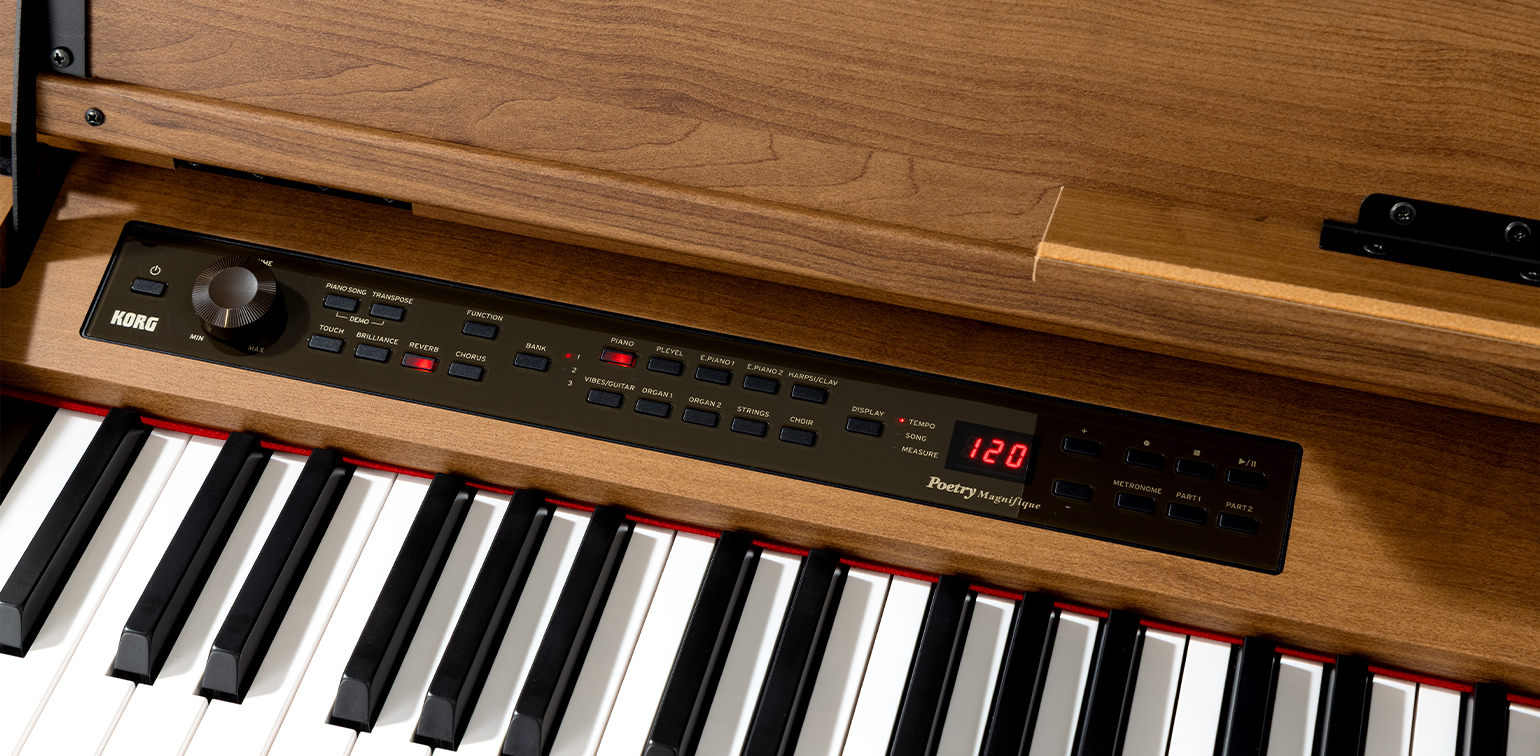
Refined elegance in woodgrain
The beautifully elegant woodgrain finish, named “Poetic Brown”, evokes the gentle warmth and refined aura of Chopin himself. With its calm, sophisticated presence, this finish harmonizes effortlessly with a wide range of interior styles, blending seamlessly into any living space. Subtle details, such as the red felt accents at the base of the keys and pedals, complete the design with a touch of luxury.
Smooth, modern surface with the lid closed
Poetry Magnifique continues the much-praised tradition of a lid that closes into a perfectly flat surface. When not in use, the piano takes on the refined appearance of a single, smooth panel, blending effortlessly into living rooms, salons, and any interior with a stylish presence. The flat top also adds practical versatility—ideal for placing sheet music, jotting down notes, or simply enhancing the elegance of your space.
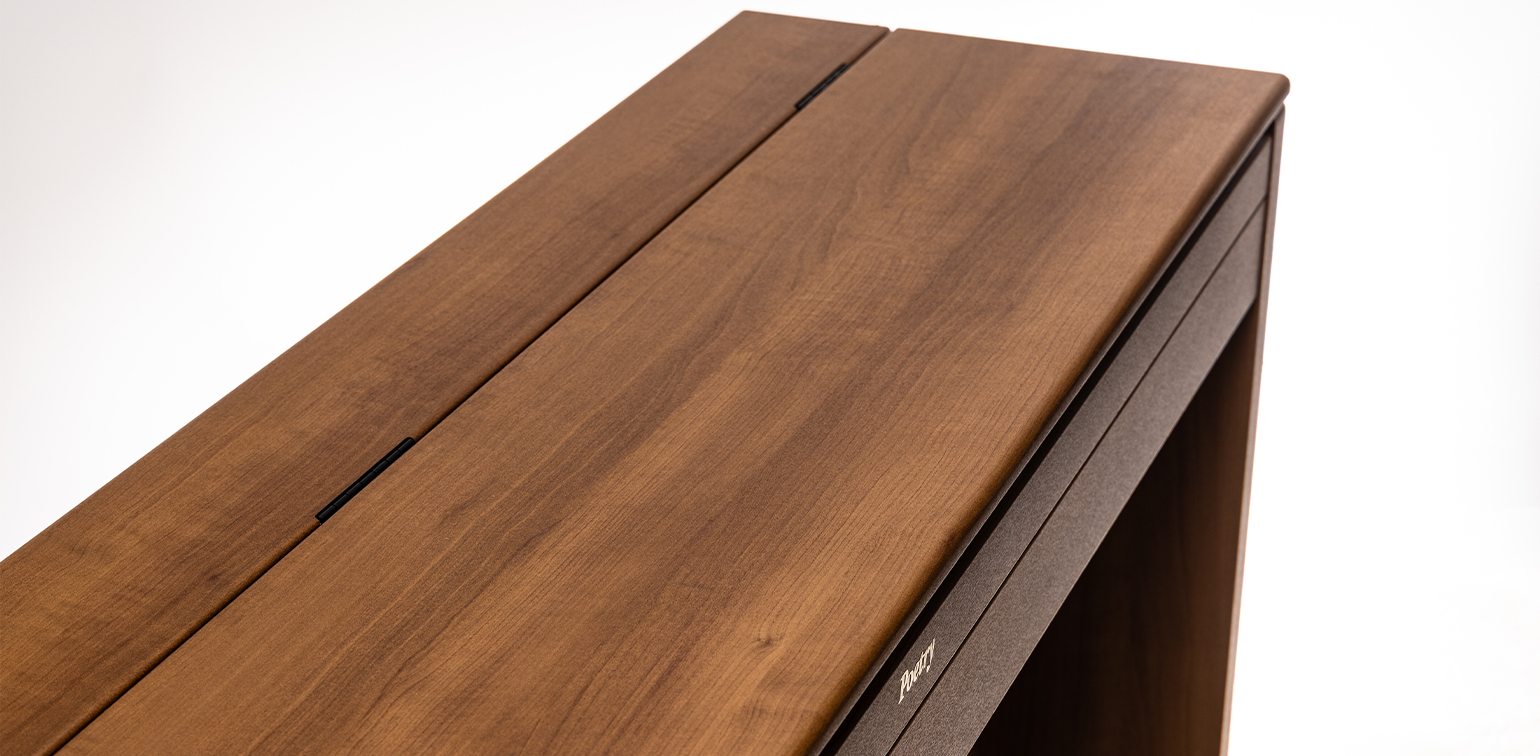
New piano structure that brings out rich resonance
To fully capture the beauty of its two iconic piano voices and a wealth of expressive sounds, Poetry Magnifique has been meticulously refined—from its power supply to its materials and assembly design.

EvoTone: A new chapter in sound evolution
Great sound is about more than high-quality samples. It depends on every part of the signal path, including how power is delivered. EvoTone is Korg’s dedicated internal power system, developed specifically for digital pianos. Unlike the standard AC adapters used by many brands, EvoTone provides clean, consistent power that reduces noise, minimizes distortion under dynamic load, and allows the full tonal range of the instrument to shine through.
It marks a first for Korg digital pianos and is a significant advancement in sound design. EvoTone improves attack response, enhances dynamic expression, and preserves even the subtlest musical details with exceptional clarity, especially in gentle passages and more nuanced performances.
Precision speaker design for a true piano experience
The Poetry Magnifique features a meticulously tuned speaker system that faithfully reproduces the depth and brilliance of an acoustic piano. The result is sparkling highs, warm lows, and a balanced midrange delivered with clarity and presence. Every detail, from materials and mounting structure to enclosure design, has been refined for maximum musicality.
Cabinet that supports the sound
The new cabinet is more than just a visual statement. It plays a key role in shaping the instrument’s sound. Its rigid and tightly sealed construction helps control speaker resonance and improves definition across the frequency range. To ensure direct, clear projection, the speakers are positioned at the front of the unit, preventing muffling even when placed against a wall. With a built-in power supply, the E1 Air eliminates the need for an external adapter, keeping your setup clean and unobtrusive - ideal for smaller spaces.
RH3 keyboard – designed for the perfect touch
Poetry Magnifique features Korg’s Real Weighted Hammer Action 3 (RH3) keyboard, designed to replicate the nuanced feel of a grand piano. The key weight is graded across the range, offering a heavier touch in the lower register that becomes lighter toward the top - just like an acoustic instrument. Highly responsive to fast repetition and subtle dynamics, the RH3 accurately captures the full expression of your performance. Key touch control offers five selectable sensitivity levels (light, normal, heavy, stable, fixed), allowing you to tailor the response to your personal playing style.

Stereo Sound Optimizer
The Stereo Sound Optimizer creates a sense of natural acoustic presence when playing with headphones. It enhances spatial depth and realism, ensuring a more immersive and comfortable listening experience, even during longer sessions.
Full 3-Pedal System with Half-Pedal Support
Poetry Magnifique includes a full three-pedal system - damper, soft, and sostenuto - just like a traditional piano. Both the damper and soft pedals support half-pedaling, enabling greater nuance and control over your expression. The pedal positioning has also been carefully refined to provide a more natural and comfortable playing experience.
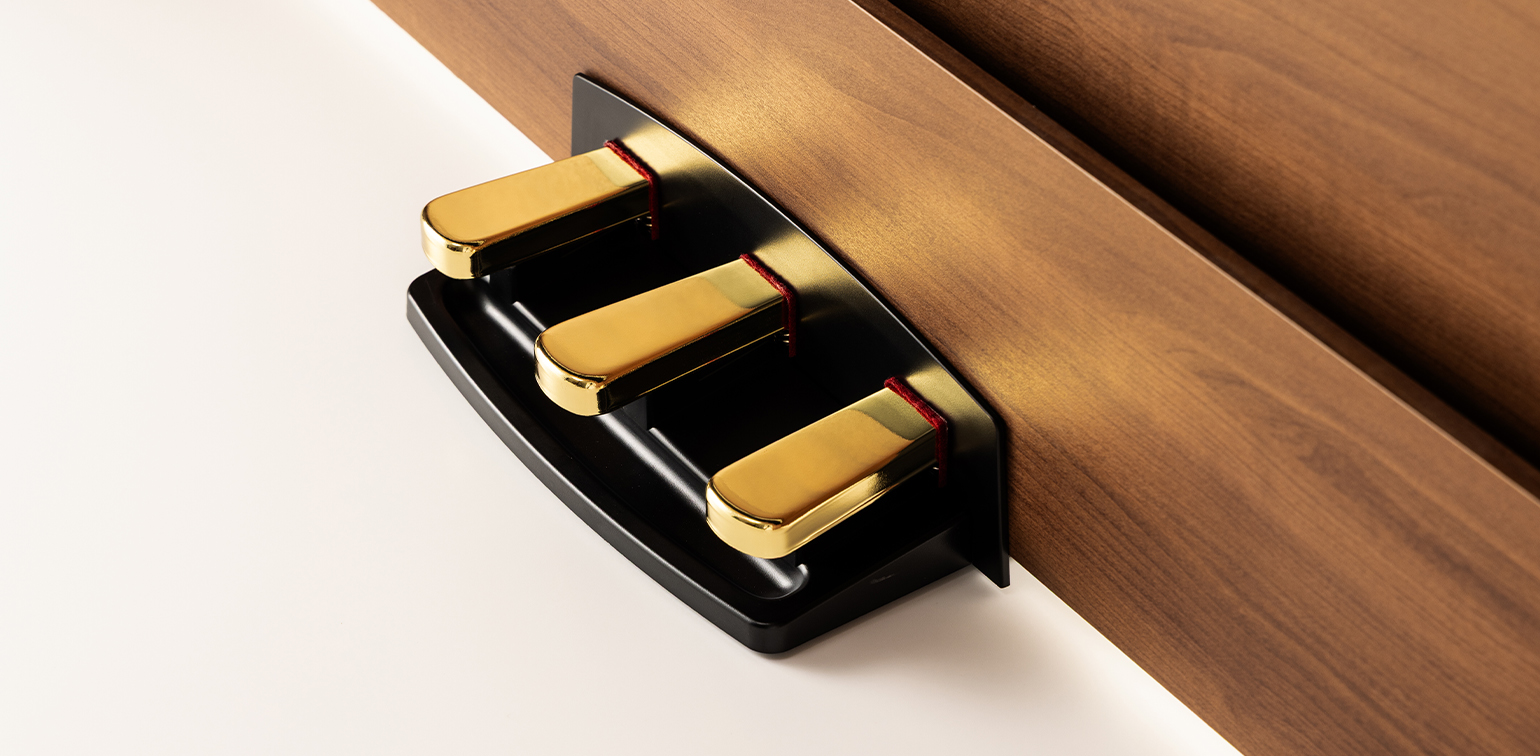
Bluetooth audio support
Connect a Bluetooth device such as a smartphone to the Poetry Magnifique and enjoy playing the piano along with your stored music or other audio. When you are not playing the piano, you can use the Poetry Magnifique as a powerful Bluetooth speaker system.
USB MIDI/AUDIO
Using a standard USB cable*, the E1 Air connects to your smartphone, tablet, or computer for expanded creative possibilities. Use it as a MIDI controller to trigger external sound modules, record your performance as MIDI data, or play audio from your device directly through the E1 Air’s built-in speakers.
*A USB cable (sold separately) is required to connect to a PC, smartphone, or tablet. For iPhone or iPad, a Lightning-USB camera adapter (sold separately) may be needed, depending on the device.
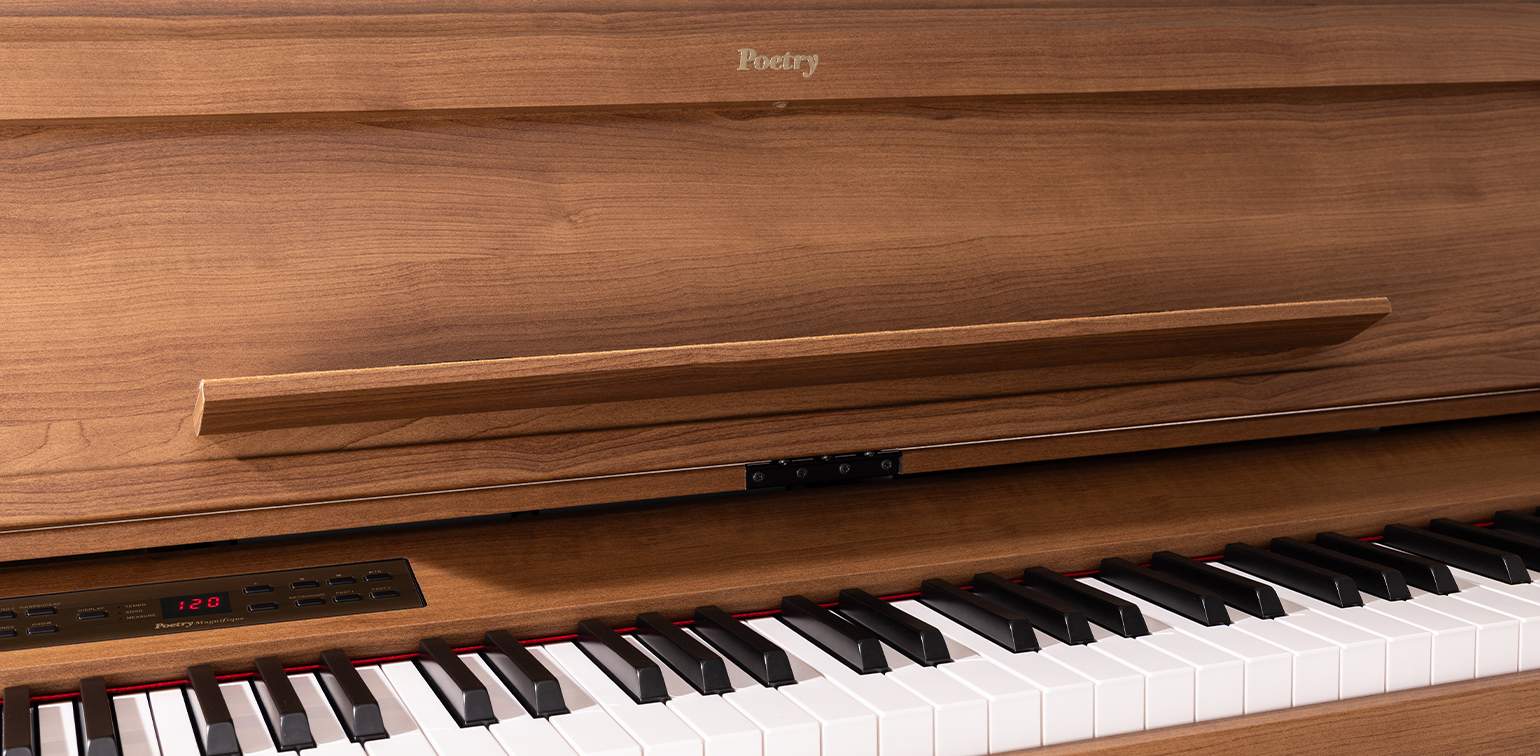
Commitment to the PLEYEL Sound
Imagining the very tones Chopin once played, Poetry Magnifique incorporates unique innovations made possible only by a digital piano, faithfully capturing the character of the PLEYEL sound.
“PLEYEL3” program – Recreating the original 80 keys
Poetry Magnifique offers three variations of the PLEYEL sound. Among them, PLEYEL3 faithfully reproduces the authentic 80-key range of the original instrument. Since Poetry Magnifique itself has 88 keys, the upper and lower eight keys produce no sound when this program is selected—an uncompromising detail that reflects our dedication to historical authenticity.
Switch easily to the historical PLEYEL pitch (430Hz)
Unlike the standard modern pitch of 440Hz used in most pianos today, PLEYEL instruments were tuned slightly lower at 430Hz. To let you experience the authentic atmosphere of that era, Poetry Magnifique allows you to switch to 430Hz with just three button presses*. By selecting “PLEYEL3” and setting the pitch to 430Hz, you can more deeply feel the ambiance of the music as Chopin himself would have played it.
*Press the “FUNCTION” button, then the “PIANO” button (to enter Pitch Setting Mode). Press the “DISPLAY” button to set the pitch to 430Hz. To return to the standard setting, press the “+/”* buttons simultaneously.
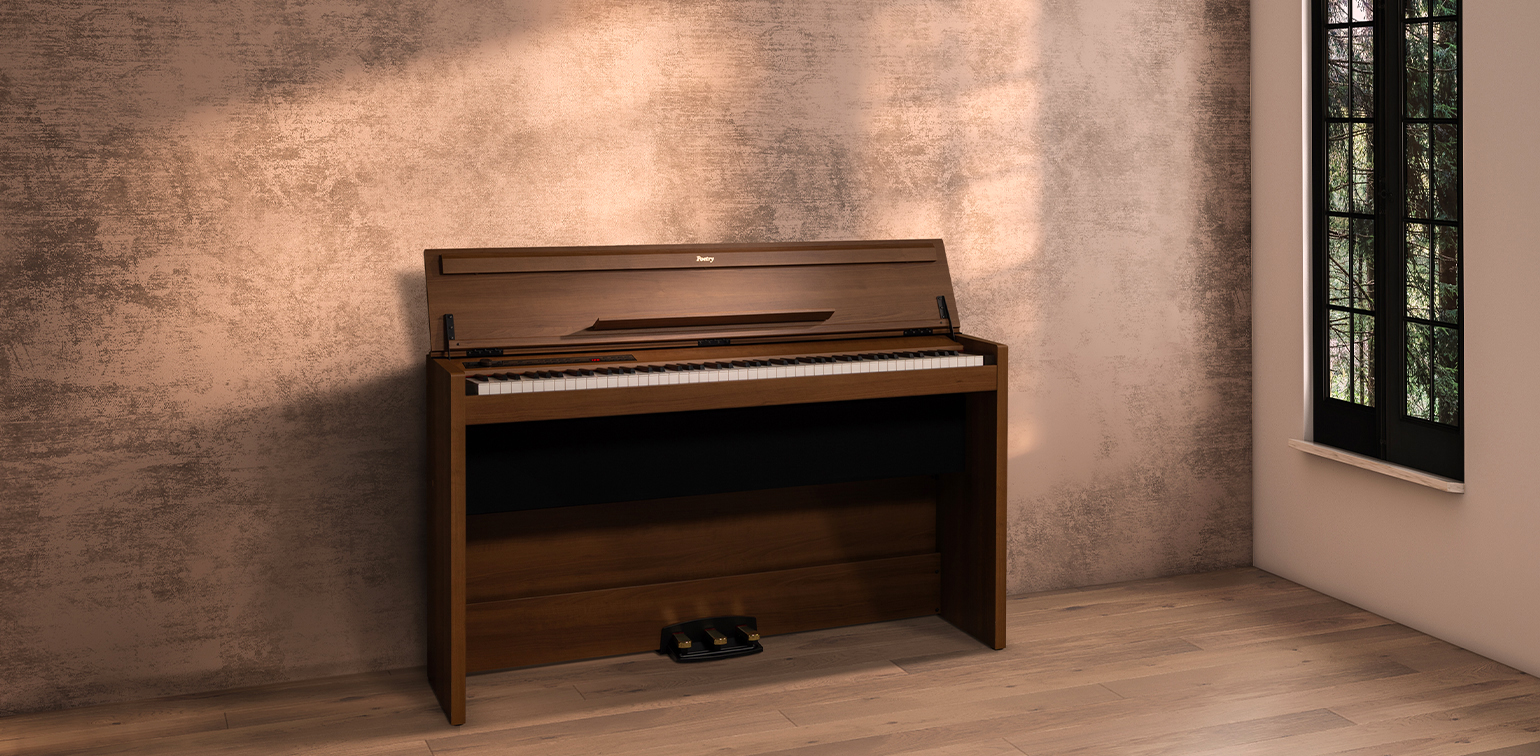
About PLEYEL Piano

About the 1843 PLEYEL
The 1843 PLEYEL piano featured in Poetry is a remarkable piece crafted during Chopin's 33rd year. Transported to Japan in its original state from its home in France, meticulous restoration efforts were undertaken. Only consumable parts requiring replacement were sourced locally, while non-consumable components were specially ordered from France. The result is a faithful restoration, preserving the piano in a condition closely resembling its original state from 1843.
Features of PLEYEL
The PLEYEL piano carries a notable anecdote tied to Chopin's insistence on retaining the "single action" mechanism. Remarkably, PLEYEL adhered to this method for 14 years following Chopin's passing. In the context of pianos, "single action" implies that the hammers must return to their original position before striking the next key, posing challenges for executing rapid sequences of notes. In contrast, contemporary pianos feature a "double escapement" construction, allowing hammers to strike againy without fully returning to the keyboard. This innovation enables rapid and flamboyant playing, contributing to the finely crafted performance experience found in modern instruments.
Indeed, the evolution of pianos has been closely intertwined with changes in performance venues. In the mid-19th century and earlier, large concert halls as we know them today were not prevalent, and salon concerts were the prevailing norm. Paintings from that era often depict scenes of intimate salon settings where musicians, including Chopin, would perform. In these images, one can observe the closeness of the audience, with individuals leaning on the piano, creating an atmosphere of shared musical experiences. As pianos and musical culture evolved, the design and acoustics of concert halls became crucial in accommodating larger audiences while preserving the rich, resonant qualities of the piano in expansive spaces.
Indeed, before the advent of the piano, keyboard instruments like the harpsichord and pipe organ were prominent. The harpsichord, while capable of producing sufficient volume for orchestral use, posed challenges when played at lower pitches. Its inherently loud nature made it less suitable for the more intimate settings of salons. In response to this, the 'fortepiano,' which later evolved into the piano, was introduced.
The fortepiano addressed the volume issue by incorporating a hammer action mechanism, enabling it to produce both strong and soft notes. This innovation allowed musicians to play at varying volumes, a crucial development for performances in smaller venues like salons. During this period, the ability to control and play at a low volume was highly valued, marking a significant shift in the evolution of keyboard instruments.
The PLEYEL, distinguished by its thoughtful design, features a mute plate that serves to modulate the volume across registers. Specifically, it reduces volume in the middle and lower registers while allowing a crescendo towards the upper registers, fostering a harmonious musical balance. Even with these considerations, the PLEYEL is renowned for its capacity to articulate music with delicate expression, emphasizing nuanced subtleties rather than sheer fortissimo power. It stands as a testament to the artistry and craftsmanship dedicated to creating an instrument that resonates with beauty and musical sensitivity.
About Chopin

National Museum in Warsaw, Public domain, via Wikimedia Commons
Frédéric François Chopin
Frédéric François Chopin (1810-1849) was born in the village of Żelazowa Wola near Warsaw, Poland, to a French father, Mikołaj Chopin (1771-1844), and a Polish mother, Justyna Krzyżanowska (1782-1861). She was born in the village of Żelazowa Wola near Warsaw, Poland.
In his short life of only 39 years, Frédéric Chopin produced a large number of works using his unique compositional techniques and pianism, which were born from his exceptional sensibility. He has been called the "Poet of the Piano" because most of his works are piano pieces. It goes without saying that his lyrically beautiful melodies, colorful harmonies, and brilliant passages are unique in every way, touching the souls of music lovers everywhere.
It should be noted that Chopin's childhood musical education was extremely classical, which became the foundation for his later compositional activities. The influence of both Johann Sebastian Bach (1685-1750) and Wolfgang Amadeus Mozart (1756-1791), in particular, is evident in the compositional and tonal relationships, the counterpoint technique (a technique of layering multiple independent melodies harmonically while maintaining their independence) that appears in his works. In addition, the use of vocal techniques and fingerings, the composition style, tonal relationships, vocal techniques, fingering, and other aspects of Chopin's music are highlighted across all his works.
It is also important to understand the history of Poland during Chopin's lifetime.
In 1795, Poland was partitioned between Russia, Prussia (the predecessor of Germany), and Austria (the third partition), and remained off the world map for 123 years until the end of World War I in 1918.
In 1830, the year of the November Uprising, Chopin left Poland at the age of 20 with a sense of regret but finally found a place to work in Paris, France, where he would eventually establish his reputation as a composer and pianist.
In his works, Chopin projected the scenery and culture of his Polish homeland, and above all, his pride and identity as a Polish person, which he carried in his heart to distant lands.
Chopin and Pleyel Piano
“If I’m not feeling on top form, I prefer to play on an Érard, for its bright and ready-made tone. But if I feel alert, ready to make my fingers work without fatigue, then I prefer a Pleyel”. This statement by Chopin has become famous. In 1830s France, when Chopin began living in Paris, there were two major piano makers, Érard and Pleyel. While the Érard pianos were characterized by their gorgeous sound, rich volume, and easy to play functionality, the Pleyel pianos were soft and delicate, sensitive to even the slightest change in touch, and were said to be instruments that required a great deal of performing nerve. The variety of sounds produced by the Pleyel, drawn from its delicate touch control, was essential to Chopin's works, and it was his preferred musical partner.
50 Chopin masterpieces within Poetry Magnifique
Immerse yourself in the world of Chopin with 50 masterpieces thoughtfully curated on the piano itself. Explore and compare the enchanting tones of the Italian piano and the PLEYEL tone, quickly and easily. Have beautiful background music played by Poetry! Additionally, indulge in the joy of playing using the 23 meticulously selected piano scores included, enabling you to relish both listening to and playing beautiful music the moment you acquire your own Poetry. To further captivate your musical senses, delight in 10 additional tone demo songs that showcase the instrument's diverse capabilities.

Poetry Magnifique dedicated piano chair, PC-400PB.
The PC-400PB piano bench has a color and wood grain tone that matches the "Poetic Brown" coloring of the Poetry Magnifique digital piano.
